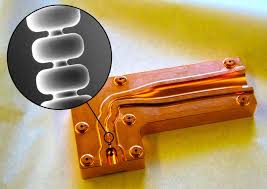U.S. scientists have invented a microscopic copper accelerator that could make future X-ray lasers and accelerators for radiation therapy far more compact.
Particle accelerators generate high-energy beams of electrons, protons and ions for a wide range of applications including X-ray lasers that film molecules during chemical reactions and medical devices for treating cancer.
Scientists at the Department of Energy’s SLAC National Accelerator Laboratory has invented a new type of accelerator structure that delivers a 10 times larger energy gain over a given distance than conventional ones. The one invented in this study was only 0.2 inches long.
Instead of conventional radio waves, the scientists used terahertz waves which are 10 times shorter, making cavities in a terahertz accelerator also much smaller.
One major challenge to building these tiny cavity structures is to machine them very precisely. Over the past few years, SLAC teams developed a way to do just that.
The researchers are planning to turn the invention into an electron gun to produce incredibly bright beams of electrons for discovery science, including next-generation X-ray lasers and electron microscopes that would allow us to see in real time how nature works on the atomic level. These beams could also be used for cancer treatment.
